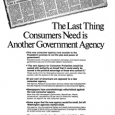Consumer Product Safety
Consumer product safety became an animating political force on the national level during the 1960s. In 1972, the Consumer Product Safety Commission (CPSC) was created to regulate and, if necessary, recall and ban products deemed unsafe for the public. Many consumables are not covered by this agency, because other federal agencies already have jurisdiction over such dangerous products as cars, alcohol, guns, and pesticides. One of the CPSC’s major accomplishments was the ban on lead paint in 1977.
Commentary
Cry Wolf Quotes
It is unreasonable to assume that existing bureaucratic lassitude will be corrected by establishing another layer of bureaucracy.
The class-action bill would open a happy hunting preserve to ambitious lawyers with a quick eye for the plump bird. They are not likely to be much concerned with fraud in the ghetto: No money there. But has a major manufacturer gotten a little too exuberant in his advertising? Has he promised a ‘benefit’ that may not be fully deliverable? Well, then, let us find 10 customers ready to say they’ve been damaged, and let us sue in the name of 10,000 more.
To the extent that [this legislation] seeks to make varying warranties fit into identical standards, it discourages competitive diversity from coming into play, and to that extent fails to serve the interests of either consumers or business.
There are bureaucrats in Washington who believe their judgment is superior to yours, as a consumer. So they want to “protect” you by insuring that the only choices open to you are those meeting with their approval. They are really a warmhearted bunch. Just a little conceited, that’s all.
Related Laws and Rules
Backgrounders & Briefs
Good Rules: Ten Stories Of Successful Regulation
Demos looks at ten laws and rules that we take for granted.
Resources
Consumer Federation of America defends the consumer interest in fields ranging from housing and financial services to food safety.
National Highway Traffic Safety Administration is the agency that oversees auto and highway safety regulations, auto recalls, and CAFE standards.
Advocates for Highway and Auto Safety is an alliance of consumer, health and safety groups and insurance companies and agents working together to make America's roads safer.


